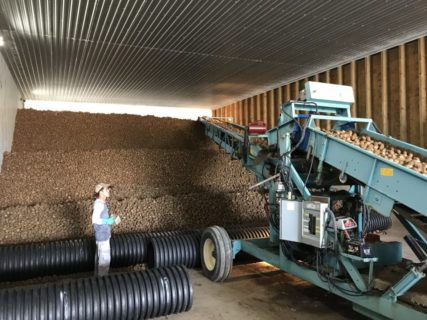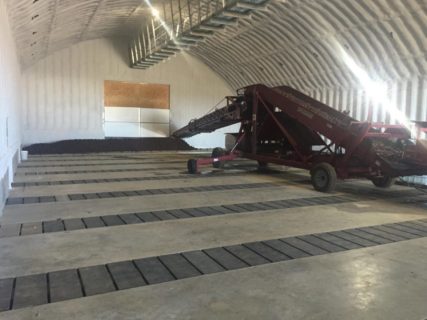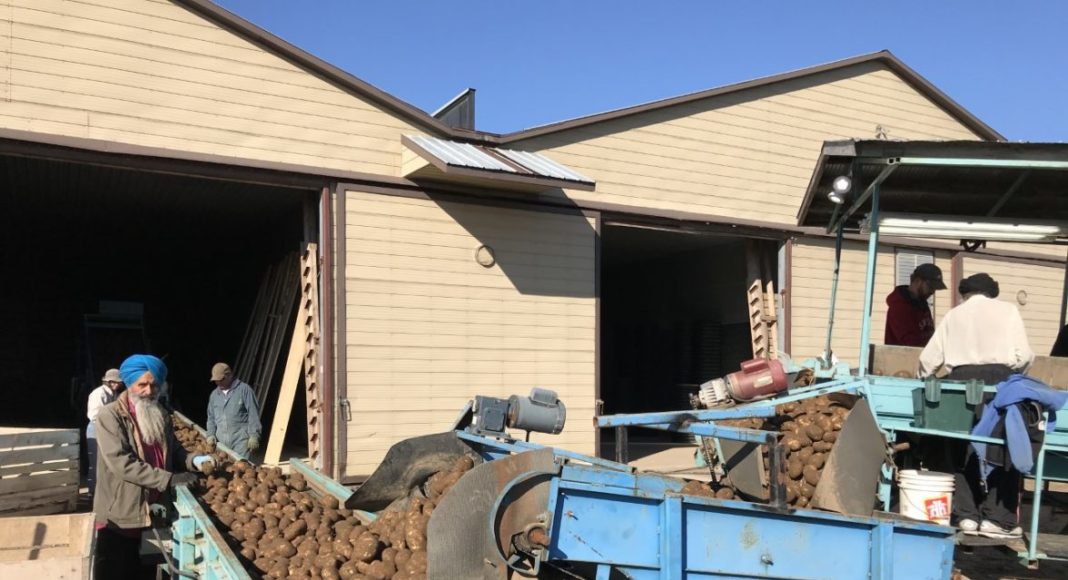[deck]Three potato experts share some tips on how to achieve storage success.[/deck]
Peter VanderZaag, co-owner of Sunrise Potato Storage Ltd. in Alliston, Ont. and a prominent Canadian potato scientist, learned a valuable lesson about storing spuds from his father, one of his mentors for growing potatoes.
Potatoes, he was told, should look as good coming out of the bin as when they’re freshly harvested. The reason being the price farmers pay if they’re not.
“If you don’t do the storage properly, you have nothing but cattle feed, and that doesn’t pay anything,” says VanderZaag.
Marlon Kuhl of Southern Potato Co. in Winkler, Man., agrees that long-term potato storage can be a high-stakes game.
“The most important reason to have the right storage environment would be that you’ve got a lot of money invested into that crop at that point,” he says.

“When potatoes go into storage, they can be a long time frame away from marketing. That’s why it’s so important that they’re stored well, and the storage is managed properly, until they get marketed. This is to ensure the quality of the crop for the customer they’re being sold to and also the profitability back to the farmer.”
As potato growers know, maintaining that quality over the course of a long storage season, however, is a long way from easy. Nora Olsen, a noted potato researcher at the University of Idaho, along with VanderZaag and Kuhl, were asked to share some tips for growers that could provide the best chance of storage success.
Olsen believes a good first step for potato farmers is to have a firm understanding of what their storage facilities can and can’t do.
“A really important concept is knowing the pros and cons of your storages, because they all have their capabilities and limitations,” she says.
“What is your fan capacity? What is your humidification indication ability? Is it the right fit and design, both for the area that you’re farming and for the kind of potatoes that are going into the bin? Having that specific knowledge about things like this for each storage is very important.”
Once potatoes are ready to go into the bin, our experts agreed that ensuring proper ventilation, humidification and temperature settings in a storage facility will not only help keep the tubers in good physiological condition, it will prevent or reduce disease in the pile.
Different Characteristics
With more than 2,000 acres of potato production, Southern Potato Co. is one of Manitoba’s largest potato farms and has an extensive storage system in place for holding its hefty crop of chipping, table and seed potatoes.

Kuhl says because different characteristics are sought out by different markets, the optimal environmental conditions and best practices for storing fresh, processing and seed potatoes will differ as well.
“The kind of potatoes you’re storing, whether it’s fresh potatoes or processing potatoes, is going to change the management practices,” he says. “The ultimate goal is to get the best quality into the hands of your customers. Disease control is part of it. Fry quality is part of it for processing potatoes. For any potato really, moisture loss and pressure bruising are a big thing for sure.”
VanderZaag’s Sunrise Potato operation grows primarily chipping potatoes but also table and some seed potatoes. Its state-of-the-art storage facilities feature 20 bins that can hold up to 400,000 hundredweight of potatoes, which are shipped out to customers from harvest time all the way to the following July.
VanderZaag says one of the key considerations for him when storing chipping potatoes is biochemistry.
“The paramount important thing is the sucrose and glucose levels in those tubers,” he says. “You have to first of all know how to manage those two parameters, and then think about diseases, about pressure bruising. They all go hand in hand.”
Sucrose and glucose levels in stored potatoes are primarily a function of temperature, says VanderZaag. At Sunrise Potatoes, potato samples are tested every two weeks to ensure that sugar levels are where they should be.
“Sugar levels generally predict the chip quality, and you need to manage your storage temperature, humidity and carbon dioxide levels accordingly,” says VanderZaag.
“If the sugars are too high, you’ll want to keep the temperature high to burn off more sugars,” he adds. “But if temperature is raised too high, you’ve got weight loss and decay to worry about, so you’ve got to balance those things out.”
Olsen agrees. “It’s very important to maintain the proper temperatures to maintain that quality specific to processing potatoes.”
Proper Ventilation
Ventilation is a key aspect of temperature control in potato storages, helping to dry and cool down the crop when it is brought into store and remove respiration heat throughout the storage season.
Part of proper ventilation is having a positive and uniform airflow that ensures there are no hotspots, which can lead to condensation buildup and increased risk of bacterial or fungal tuber disease and sprouting.
“When you’re dropping temperatures, you want to have a uniform airflow throughout your pile, but also that you’re running enough volume of air so your pile is going to be at an even temperature from the top to the bottom, or at least mostly even,” says Kuhl.
Olsen recommends growers try to avoid temperature fluctuations in the storage and strive to maintain a delta T (the difference in temperature between the top and bottom of the pile) of between 0.5 and 2 F (0.25 to 1 C).
Too much airflow can cause dehydration in stored potatoes and inadequate humidification can contribute to pressure bruising, so ensuring proper airflow and humidity levels in potato storages is a must.
Olsen says maintaining the right relative humidity, along with proper temperature and airflow, is particularly important in the first 30 days after potatoes go into the bin, which is when the tubers experience the most moisture loss.
“If you bring in potatoes with high pulp temperatures, you will need to remove that field heat as soon as possible,” Olsen says. “This helps in disease control and to minimize higher shrinkage due to warmer temperatures.” Heat needs to be controlled and pile temperatures equilibrated with ventilation, she says, and the appropriate humidity is required to minimize the vapor pressure deficit between the air and the potato.
“Strive for high humidity but not to the point where water condenses based upon temperature differences within the pile. Any time there is condensation or free moisture in the pile, there is a greater risk for disease,” says Olsen.
Kuhl believes that as long as there’s no disease in the pile, relative humidity in storage should be kept at 98 or 99 per cent for table crops and about 95 per cent for processing potatoes.
Kuhl adds if any disease or rotting tubers are observed in the pile, it’s a good idea to reduce the relative humidity to help dry down the potatoes. “The point is to try and dry out those parts of the pile and get that under control.”
Eye and Nose Test
According to Kuhl, one of the keys to making good storage decisions is keeping a close eye on the crop.
“The biggest thing is to be in your storage regularly, know what quality you think you put in there but also be monitoring your quality throughout the season,” says Kuhl.
“If that’s chipping potatoes, for example, you want to be doing regular samples to ensure your fry quality and your chemical maturity are where you think they should be, and then make good temperature decisions based on that.
“It’s easy to kind of close the doors and check the storage occasionally and hope for the best. But the more time a person can spend managing the environment the potatoes are in, the better the outcome is going to be in the end.”
VanderZaag says there are lots of ways technology is being used these days to enable growers to monitor storage conditions remotely, but he believes there’s no real substitute for the eye and nose test for detecting rotting or diseased potatoes in the pile.
“You cannot replace the nose. To me, this is crucial,” he says. VanderZaag recommends growers or their staff visit their potato storage bins at least every two or three days to check for any suspicious smells or visible signs that could spell trouble.











